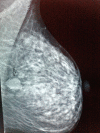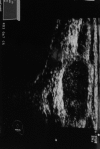Tubular adenoma of the breast: a rare presentation and review of the literature
- PMID: 22383931
- PMCID: PMC3279505
- DOI: 10.4021/jocmr746w
Tubular adenoma of the breast: a rare presentation and review of the literature
Abstract
Tubular adenomas, also known as pure adenomas, are rare epithelial tumors of the breast. Only a few cases have been reported in the literature, especially in young women of reproductive age. Postmenopausal women are very rarely affected. We describe here a very rare case of tubular breast adenoma in a postmenopausal woman who presented with a gradually enlarging breast lump. Clinical examination and imaging studies revealed a non-tender well circumscribed left breast tumor suggestive of a fibroadenoma. Due to the history of progressive enlargement of the breast lump, a surgical excision was performed. Histological findings were suggestive of a tubular breast adenoma. We conclude that although tubular breast adenoma is rare, it should always be considered in the differential diagnosis in postmenopausal patients presenting with a gradually enlarging breast mass. Preoperative diagnosis is difficult because tubular adenoma is indistinguishable from a fibroadenoma on physical examination and breast imaging. Surgical excision is necessary to establish a definitive diagnosis. Clinical presentation and management of our patient are discussed along with a review of the literature.
Keywords: Tubular adenoma; Breast; Breast mass.
Figures



References
-
- Tavassoli FA, Devilee P. Pathology and genetics of tumors of the breast and female genital organs. World Health Organization Classification of Tumors. Lyon, France: IARC; 2003. Tumors of the breast; pp. 9–112.
-
- Persaud V, Talerman A, Jordan R. Pure adenoma of the breast. Arch Pathol. 1968;86(5):481–483. - PubMed
-
- Moross T, Lang AP, Mahoney L. Tubular adenoma of breast. Arch Pathol Lab Med. 1983;107(2):84–86. - PubMed
-
- Rovera F, Ferrari A, Carcano G, Dionigi G, Cinquepalmi L, Boni L, Diurni M. et al. Tubular adenoma of the breast in an 84-year-old woman: report of a case simulating breast cancer. Breast J. 2006;12(3):257–259. - PubMed
-
- Hertel BF, Zaloudek C, Kempson RL. Breast adenomas. Cancer. 1976;37(6):2891–2905. - PubMed
LinkOut - more resources
Full Text Sources
Molecular Biology Databases
